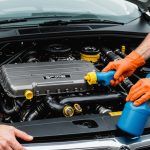Introduction to DIY Paint Touch-Ups for Kawasaki Ninja 300
For many motorcycle enthusiasts, maintaining the aesthetic appeal of their Kawasaki Ninja 300 is a top priority. The sleek, dynamic appearance of this motorcycle model is a significant part of its allure. Unfortunately, everyday riding can lead to common damages such as chips, scratches, and fading, detracting from the bike’s overall look.
Taking a DIY approach to paint touch-ups can be a pragmatic and rewarding solution. Performing this maintenance on your own can be more cost-effective than hiring professionals and provides a sense of accomplishment. Moreover, DIY paint touch-ups allow owners to address issues immediately, preventing further damage and keeping the Kawasaki Ninja 300 looking its best.
Also to read : Step-by-Step Guide to Identifying and Repairing Fuel Injector Issues on Your BMW S1000XR
Common wear and tear on a Kawasaki Ninja 300 might include road debris scratches, sunlight exposure fading, and general abrasion from use. Addressing these promptly can preserve both the look and the value of the motorcycle. By understanding the value of a DIY touch-up, riders can better maintain the charm and integrity of their beloved bikes. This solution not only saves money but also empowers owners to keep their motorcycles in prime aesthetic condition.
Essential Tools and Materials
When performing a paint touch-up on your Kawasaki Ninja 300, having the right tools and materials is critical to achieving a flawless finish. Here is a streamlined guide to essential items you’ll need.
Topic to read : How do you navigate through urban traffic safely on a motorcycle?
For a successful paint touch-up, start with these Paint Touch-Up Tools:
- Sandpaper: Use fine-grit sandpaper to smooth out any imperfections before applying paint.
- Brushes: Select small detailing brushes to ensure precision in application.
- Touch-up Pen: Ideal for small scratches, these pens allow for direct paint application.
Next, consider the appropriate paint for your motorcycle. Matching the factory paint is paramount, so for your Kawasaki Ninja 300, use the manufacturer’s paint code to find matching paint. There’s often a range of matching paint options, including spray cans or bottled touch-up paint.
When engaging in motorcycle repair materials, always prioritise safety. Essential safety gear includes:
- Gloves: Protects your hands from chemicals and paint stains.
- Mask: Ensure you wear a paint respirator mask to shield yourself from harmful fumes.
Taking these simple yet critical precautions can significantly improve your experience.
Step-by-Step Guide to Paint Touch-Ups
Mastering paint touch-up techniques is an essential part of motorcycle maintenance, ensuring your ride looks pristine and well cared for. Following a structured process is crucial to achieve professional-looking results.
Preparing the Surface
To start, clear the targeted area of any dirt and oil by thoroughly cleaning and degreasing it. This step is vital to ensure the paint adheres properly. Sanding follows as the next essential phase to smooth out the surface, which increases the likelihood of the primer sticking effectively. Use a fine-grit sandpaper for minor imperfections. Apply a primer afterwards, which gives the paint a solid base. Before proceeding, evaluate the damage meticulously to identify all areas needing attention.
Selecting and Matching Paint
Color matching is a common challenge in this process. Utilize the motorcycle’s paint codes to find the precise shade. Online resources or local paint suppliers can be beneficial for this task. Before large-scale application, it’s prudent to test the paint on a less visible part to ensure compatibility.
Application Process
For an even application, employ techniques like those using quality brushes or spray cans. Remember that success lies in applying multiple thin coats rather than a single thick one. Proper tools make a noticeable difference in outcome.
Achieving a Professional Finish
When pursuing a professional paint finish on your motorcycle, understanding the process and techniques is vital. A key element to consider is the application of clear coats. These not only enhance the durability and shine of the paint but also protect it from environmental factors. Clear coats create an additional layer of protection, which is essential for maintaining the paint’s integrity over time.
To achieve a flawless finish, buffing and polishing are crucial steps. These techniques help remove minor imperfections and bring out a high-gloss sheen. Buffing involves using a compound to smooth out the surface, while polishing refines it further, ensuring the motorcycle shines brilliantly. Both steps require precision to avoid damaging the paint.
Equally important are the drying and curing times. Allowing adequate time for each layer to dry before applying the next ensures that the paint adheres properly, preventing common issues such as peeling or cracking. Properly cured finishes are more resistant to wear and maintain their lustre longer, contributing to a professional look.
Incorporating these techniques not only improves the motorcycle’s appearance but extends its lifespan, providing a professional and resilient finish.
Common Mistakes to Avoid
When embarking on a DIY painting project, especially for motorcycles, careful attention is crucial. One frequent error is overlooking surface preparation, a step fundamental to achieving quality results. Failure to thoroughly clean and sand the surface can lead to poor paint adhesion, resulting in a lacklustre finish and a waste of time and effort.
Another mistake is ignoring colour matching. Without ensuring that your new paint matches the existing hue, the motorcycle’s appearance can become inconsistent. This often results from not considering the light under which you’re applying the paint or neglecting to test a small area first. Both are essential for ensuring a seamless look.
Rushing through the painting process is yet another pitfall. Patience is key; allowing adequate time for each coat to dry can prevent bubbling, streaking, and peeling. Motorcycle care tips often stress the importance of following the manufacturer’s instructions for the best results.
By investing time in each step, you’ll avoid these common mishaps, leading to a professional-looking finish that adds pride to your beloved ride. Embrace patience and precision for success in your next DIY adventure.
Maintaining Aesthetic After Touch-Ups
Preserving the motorcycle’s aesthetic after a repair or touch-up is crucial for enthusiasts of the Kawasaki Ninja 300. Regular cleaning and maintenance not only enhance your bike’s appearance but also extend its longevity. Wipe down the surfaces frequently to prevent dust and grime build-up, which can dull its shine over time. Reapplying wax can safeguard the paint against environmental damage, acting as an essential shield.
Protective coatings are vital post-touch-up to maintain the bike’s vibrant look. They serve as a barrier against scratches, UV rays, and pollutants, prolonging the rejuvenated appearance of the painted surfaces. Applying a ceramic or paint sealant can add that extra layer of protection.
Different seasons bring unique challenges. In winter, protect your motorcycle from salt and potential rust by using rust inhibitors. In spring and summer, focus on protecting the bike from UV exposure with sun protectants. Autumn often includes dealing with rain and mud, so apply water-repellent products for easy cleaning.
By incorporating these bike care tips, your Kawasaki Ninja 300 will retain its pristine appearance, drawing admiration for miles to come.
Overview of DIY Paint Touch-Ups
Maintaining the motorcycle aesthetics for your Kawasaki Ninja 300 is crucial for not just visual appeal, but also for preserving its value. A well-maintained bike not only turns heads but also communicates the care and pride you take in your ride. DIY paint touch-ups provide an economical solution to keep your bike looking its best.
Many motorcycle owners encounter common issues like minor scratches, paint chips, and scuffs that can detract from the visual appeal of their Kawasaki Ninja 300. Engaging in DIY paint touch-ups addresses these problems effectively. By fixing imperfections early, you mitigate further damage to the paintwork, maintaining the bike’s original charm.
The benefits of DIY paint touch-ups extend beyond cost-effectiveness. They offer a sense of satisfaction and empowerment as you are actively involved in the upkeep of your motorcycle aesthetics. No longer is there a need to frequently visit workshops for minor issues. Instead, you can maintain and perfect your Kawasaki Ninja 300 at your convenience.
Equipped with the right tools and knowledge, enhancing your bike’s aesthetics becomes a rewarding project. Contribute to your bike’s longevity and enjoy the ride with pride, knowing your Kawasaki maintains its polished, factory-fresh appearance.
Essential Tools and Materials for Paint Touch-Ups
When it comes to performing paint touch-ups on your Kawasaki Ninja 300, having the right tools and materials is crucial. Let’s dive into the essentials you’ll need to achieve a professional finish.
Key Paint Touch-Up Tools
For precision work, a variety of paint touch-up tools is essential. Start with a range of brushes, crucial for small and intricate areas. Fine-tip brushes offer control and are ideal for detailed sections. For a broader application or larger parts, spray cans and painting materials like rollers come in handy.
Suitable Paint Types
Selecting the right type of paint for the Kawasaki Ninja 300 is vital. OEM paint ensures a match with the original colour, maintaining the bike’s seamless look. Always check the formula to ensure it adheres well to the bike’s surface and withstands environmental exposure.
Additional Materials
In addition to the paint itself, you’ll require extra materials. A primer helps prepare the surface, enhancing the paint’s adherence. After applying the paint, a clear coat is essential to protect it and bring out a polished shine. Remember, the primer and clear coat should be compatible with the paints used.
Preparing Your Kawasaki Ninja 300 for Touch-Ups
Getting your Kawasaki Ninja 300 ready for touch-ups is crucial for achieving a seamless finish. This involves several steps, including motorcycle preparation, surface cleaning, and the paint application process.
Cleaning the Surface
Begin with a clean motorcycle surface. This is essential to ensure the new paint adheres properly. Remove any dirt, grease, or wax using a soft cloth and a mild detergent. Pay particular attention to crevices where grime can accumulate. Rinse thoroughly and let the surface dry completely before proceeding.
Assessing Damage
Once your motorcycle is clean, assess the extent of the paint damage. Carefully inspect the scratched or chipped areas. Determine if the damage is limited to the top coat or has affected multiple layers of paint. This evaluation helps in deciding the level of repair needed. For superficial scratches, a simple touch-up might suffice, but deeper damage could require more intricate work.
Masking and Protection
Masking areas around the damaged spots is vital to prevent overspray during the paint application process. Use painter’s tape and plastic sheeting to cover adjacent surfaces. Make sure all hardware components like lights, mirrors, and tyres are adequately protected. Proper masking ensures a professional-looking result by keeping the rest of your motorcycle untouched by the new paint.
Techniques for Color Matching
Successfully color matching is crucial for maintaining the aesthetic of your Kawasaki Ninja 300, especially when addressing dings or repainting is necessary. Understanding factory colors and codes is the first step. The Ninja 300’s specific paint codes are essential; they ensure you’re working with the exact colors originally used by the manufacturer. Without these codes, achieving a precise match becomes significantly more challenging.
Paint blending methods are also vital when touching up your bike. One effective approach is to incrementally apply layers of paint, allowing each to dry before applying the next. This technique helps to achieve a smooth, consistent look that closely resembles the factory finish. Testing your paint samples in inconspicuous areas can aid in perfecting this blend. If you’re unsatisfied with your match, recollecting and adjusting your samples based on lighting and material texture observations may be necessary.
Lastly, the goal is achieving a seamless blend with the existing paint. Utilise gentle sanding techniques between paint layers to avoid any ridge formation. This meticulous approach ensures your Ninja 300 maintains its flawless appearance, reflecting the same allure as it did when it first rolled off the production line.
Step-by-Step Application Process
Before diving into the Kawasaki Ninja 300 restoration, understanding the paint application process is crucial for achieving professional results.
Preparing Paint
For a smooth application, meticulous preparation is key. Begin by matching the new paint exactly to the existing hue, ensuring seamless touch-up techniques. Clean the surface thoroughly to remove dirt, grease, and dust. Sand down any imperfections, utilising fine-grit sandpaper for a pristine finish. Finally, mix the paint, following the manufacturer’s ratios for the best consistency.
Application Methods
Selecting the appropriate application method greatly influences the outcome. Consider these options:
- Spray Cans: User-friendly and cost-effective, but may require skill to avoid unevenness.
- HVLP (High Volume Low Pressure) Sprayers: Offer precision and are best for larger areas, though they require a higher initial investment.
Each method has distinct pros and cons, balancing ease against quality.
Finishing Touches
Once the paint is applied, the finishing touches involve clear coat techniques. The clear coat provides shine and protects the painted surface. Apply it evenly in thin layers, allowing appropriate drying time between applications. This ensures optimal durability and lustre for your Kawasaki Ninja 300.
Common Mistakes and How to Avoid Them
When embarking on DIY paint touch-ups, it is crucial to be aware of common paint touch-up mistakes to ensure a smooth and professional finish. One prevalent error is the appearance of runs and drips, often caused by applying paint too thickly or using an inappropriate technique. To avoid this, practice patience and use thin, even coats, allowing each layer to dry completely before adding another. This approach helps maintain control and prevent drips.
Perhaps the biggest DIY errors occur when touch-ups are rushed. Patience is key in this process; hurried efforts often lead to visible brush strokes or uneven textures. Take your time, choosing the right tools such as fine brushes or spray cans specifically recommended for the job.
For Kawasaki Ninja 300 tips, remember that the bike’s surface is unique. Proper preparation, like cleaning and lightly sanding the area to be painted, is essential. This ensures adherence and a smoother finish. Additionally, matching colour perfectly is vital to avoid noticeable patches. If uncertain, consult a professional for advice on selecting the correct shade. Being mindful of these aspects will enhance the final outcome significantly.
Safety Precautions During Painting
When painting a motorcycle, following safety tips is essential to ensure both your well-being and high-quality results.
Personal Protective Equipment
Wearing appropriate personal protective equipment (PPE) is a crucial aspect of paint safety. A high-quality respirator mask is vital to prevent inhalation of harmful fumes and dust. Eye protection, such as goggles, shields your eyes from splatters. Always wear gloves to avoid skin contact with chemicals. A protective overall suit can safeguard your clothing and prevent any substance from reaching your skin, reducing irritation risks.
Ventilation and Workspace Safety
A well-ventilated workspace is non-negotiable for safe painting practices. Ensure that your area has sufficient airflow, ideally by working outdoors or in a space with powerful exhaust fans. This will help disperse toxic fumes, lowering health hazards. Adequate lighting is also important to avoid accidents and ensure precision during the painting process.
Handling Chemicals
Handling chemicals requires cautious attention to motorcycle maintenance procedures. Properly store all paint and solvents in their original containers and ensure they are sealed when not in use. Dispose of waste materials as per local regulations to prevent environmental damage. Be mindful of spillages and clean them immediately to maintain a safe work environment.
Visual Aids and Resources
Leveraging visual guides is crucial when performing paint touch-ups on a Kawasaki Ninja 300. These resources provide precise instructions, helping ensure that the repair matches the motorcycle’s original look. Painting tutorials are invaluable, especially those presented as step-by-step video guides. They reveal subtle techniques, such as maintaining consistent brush strokes and choosing the right type of paint.
Experienced bikers often recommend specific video tutorials available on platforms like YouTube. These tutorials detail every aspect of the touch-up process and are especially useful for novices. They typically include information on preparation, application, and finishing, providing a comprehensive understanding of the task.
Online forums and communities serve as a valuable support network for both beginners and experts. These platforms offer a space for enthusiasts to discuss challenges, share experiences, and offer Kawasaki Ninja 300 support tailored to the unique aspects of this model. Members frequently exchange tips on everything from selecting colours to preventing future paint chips.
In combining these resources—visual guides, video tutorials, and engaging community discussions—motorcycle enthusiasts can confidently approach paint touch-ups, ensuring a smooth and professional finish every time.










